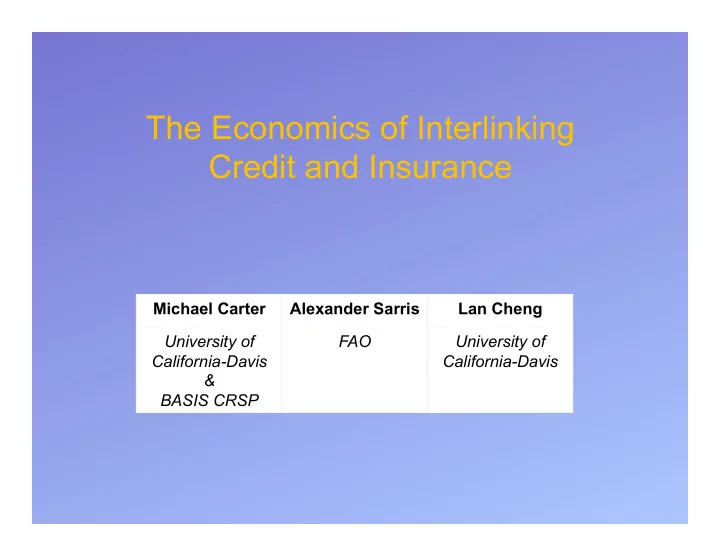

The Economics of Interlinking Credit and Insurance Michael Carter Alexander Sarris Lan Cheng University of FAO University of California-Davis California-Davis & BASIS CRSP
Challenge of Risk & Insurance • Ample evidence of uninsured risk and costly self- insurance strategies by small scale agricultural and pastoral households • Yet sometimes observe sluggish uptake of novel index insurance contracts designed to ameliorate this risk • While standard economic theory suggests that risk averse people will gladly tradeoff some expected income for reduction in the variance of income, this zero sum tradeoff may not be especially attractive in practice: – Trust in contract (and risk) – Understanding of contract – Liquidity constraints that may block purchase – Ugly tradeoff • So can insurance be turned into a non-zero sum game, offering increases in mean income and reductions in variance? • Theory of rural financial market suggests the answer is “yes”
Risk and Rural Financial Markets • Stylized features of low income, smallholder agriculture: – Costs of acquiring & transmitting information high – Strong informational asymmetries – Multiple sources of risk, much of which is correlated across individuals • These features result in endogenous market failures that militate against smallholders: – Absence of conventional insurance contracts – Supply Side Portfolio restrictions for ag loans – Contractual restrictions (relatively high collateral requirements) quantity rationing – Also risk rationing (demand side restrictions) – Destructive political economy (e.g., Rescate Financiero in Peru)
Inducing Innovation by Removing Correlated Risk • Public supply of financial services could be a response • But same conditions of risk and information that constrain private market will also undercut sustainability of public efforts • Alternatively, is it possible to modify the conditions that underlie market failure? • Index Insurance Hypothesis is that the removal of correlated risk with index insurance contracts will: – Crowd-in credit institutions and credit supply – Relax risk rationing & enhance demand – Undercut destructive political economy – Incentivize risk taking in production & accumulation • Let’s look in detail at the demand side of this story
The Demand-side Logic of Interlinking Credit & Insurance • Key point is that neither credit nor (index) insurance in isolation are likely to be adequate to achieve development objectives • Basic intuition courtesy of Braverman & Stiglitz:
A Model of Interlinked Credit & Index Insurance • Structure of production & risk: c ( Ω ) Ω – Technology purchased at price y = θ f ( Ω ); f > 0 ′ – Net income given by – Stochastic factor has idiosyncratic & correlated (across θ = r c + r individuals) elements: i , where E ( θ ) = 1 and V ( θ ) = 2( p + π ) • Actuarially un fair index insurance contracts: – Indemnities: ⎡ ⎤ z = 1( r c < r ) ( r − r c ) f ( Ω ) ⎣ ⎦ – Premium: ρ = E [ z | r c < r ] + β – Insured income stream: { } + z 1{ I = 1}1{ r c = f ( Ω ) − ρ 1 I = 1 c ≤ r c }
A Model of Interlinked Credit & Index Insurance • Individual choice problem: [ ] V ≡ max Ω , I E U ( c ) subject to : { } + z 1{ I = 1}1{ r c = f ( Ω ) − p 1 I = 1 c ≤ r c } g ( Ω ) ≤ B • Insurance purchased if: Δ V = V 1 − V 0 > 0 1 = V ( f ( Ω ) = f ( Ω *| I = 1), I = 1) where V V 0 = V ( f ( Ω ) = f ( Ω *| I = 0), I = 0)
A Model of Interlinked Credit & Index Insurance • Define V = V ( f ( Ω ) = f ( Ω *| I = 0), I = 1) and rewrite purchase decision as: 1 − V ] + [ Δ V = [ V V − V 0 ] = Δ V 1 + Δ V 0 • Natural interpretation of these two elements • Let’s illustrate with numerical analysis
Conclusion • While analysis here is highly stylized, makes three points: – Credit by itself insufficient (risk rationing) – Insurance by itself will have relatively limited reach – Interlinking the two offers important synergies, not only in terms of development effects, but also in terms of market size (and hence commercial sustainability) • We need to look further into the credit supply side of the problem—logical, interest (Mali) but still to be done • Are other important contractual design issues, including: – Demand driven, basis risk minimizing indices – Retail insurance, or – Portfolio insurance with explicit index-based debt forgiveness clause
Recommend
More recommend